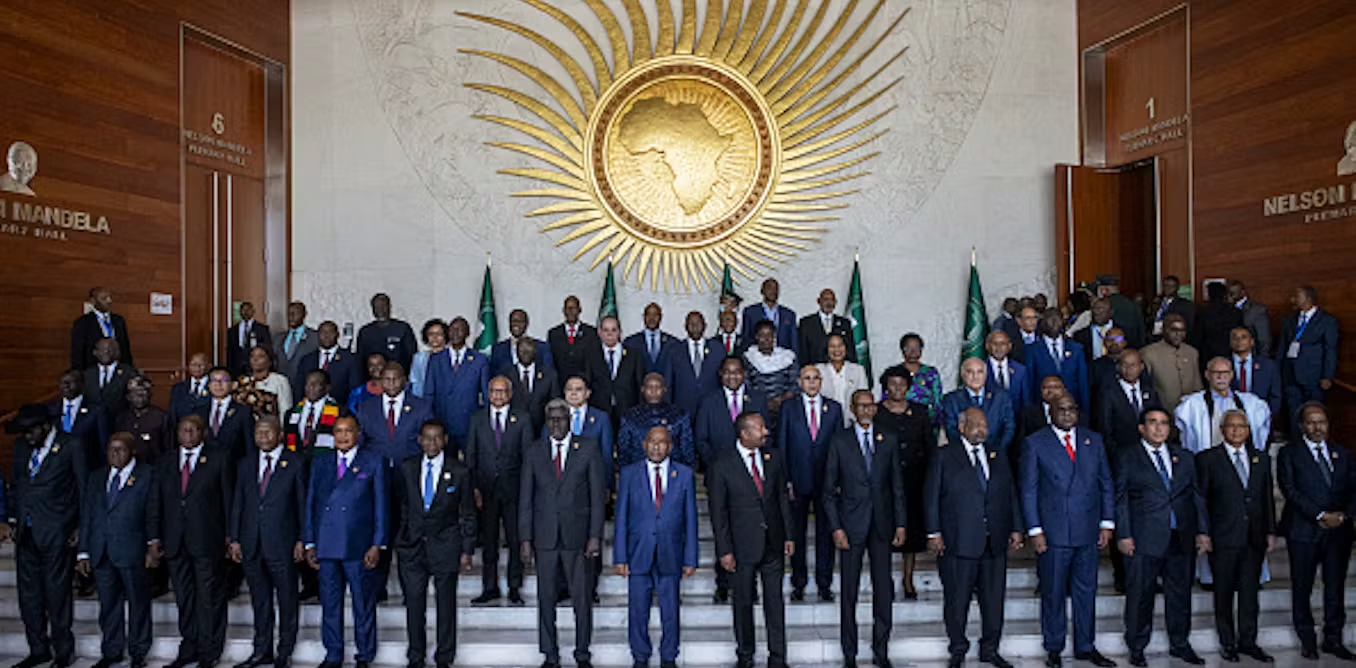The African Union (AU) is an organization consisting of African nations. It was created to foster unity, economic development, and cooperation among its member countries. The AU includes most African nations, but not every country in Africa is a member.
History Of The African Union
The African Union’s history goes back to Africa’s fight for independence. The idea of creating the AU first emerged at the First Congress of Independent African States, held in Accra, Ghana, in 1958.
This gathering brought African nations together in solidarity against colonial rule. It also led to the creation of Africa Day, an annual celebration of the continent’s liberation and its hope for self-determination.
Later, on May 25, 1963, the Organisation of African Unity (OAU) was founded in Addis Ababa, Ethiopia. It began with 32 independent African countries and focused on promoting unity and protecting their sovereignty.
However, the OAU was criticized for not addressing human rights abuses in its member countries. It was even nicknamed the “Dictators’ Club” because it often avoided taking action against oppressive governments.
By the 1990s, many African leaders felt the OAU was not effective, and they started talking about the need for a stronger organization. Libyan leader Muammar al-Gaddafi was a strong supporter of creating a new African Union.
In 1999, at a summit in Libya, the Sirte Declaration officially proposed creating the AU. This led to a new framework being drafted, and in 2000 the Constitutive Act of the African Union was adopted. The AU was formally launched on July 9, 2002, in Durban, South Africa, with Thabo Mbeki as its first chairperson.
Since then, the AU has worked on several key initiatives, including peacekeeping missions, establishing a Pan-African Parliament, and setting up the African Standby Force. In 2015, it launched Agenda 2063, a plan to transform Africa into a global economic powerhouse.
Which Countries Are Part Of The African Union?
The African Union (AU) has 55 member countries. Below is a comprehensive list of these member states:

| No | Region | Member State | Abbreviation |
|---|---|---|---|
| 1 | Central Africa | Republic of Burundi | Burundi |
| 2 | Republic of Cameroon | Cameroon | |
| 3 | Central African Republic | Central African Republic | |
| 4 | Republic of Chad | Chad | |
| 5 | Republic of the Congo | Congo Republic | |
| 6 | Democratic Republic of Congo | DR Congo | |
| 7 | Republic of Equatorial Guinea | Equatorial Guinea | |
| 8 | Gabonese Republic | Gabon | |
| 9 | Democratic Republic of São Tomé and Príncipe | São Tomé and Príncipe | |
| 10 | Eastern Africa | Union of the Comoros | Comoros |
| 11 | Republic of Djibouti | Djibouti | |
| 12 | State of Eritrea | Eritrea | |
| 13 | Federal Democratic Republic of Ethiopia | Ethiopia | |
| 14 | Republic of Kenya | Kenya | |
| 15 | Republic of Madagascar | Madagascar | |
| 16 | Republic of Mauritius | Mauritius | |
| 17 | Republic of Rwanda | Rwanda | |
| 18 | Republic of Seychelles | Seychelles | |
| 19 | Federal Republic of Somalia | Somalia | |
| 20 | Republic of South Sudan | South Sudan | |
| 21 | Republic of the Sudan | Sudan | |
| 22 | United Republic of Tanzania | Tanzania | |
| 23 | Republic of Uganda | Uganda | |
| 24 | Northern Africa | People’s Democratic Republic of Algeria | Algeria |
| 25 | Arab Republic of Egypt | Egypt | |
| 26 | Libya | Libya | |
| 27 | Islamic Republic of Mauritania | Mauritania | |
| 28 | Kingdom of Morocco | Morocco | |
| 29 | Sahrawi Arab Democratic Republic | Sahrawi Republic | |
| 30 | Republic of Tunisia | Tunisia |
|
| 31 | Southern Africa | Republic of Angola | Angola |
| 32 | Republic of Botswana | Botswana | |
| 33 | Kingdom of Eswatini | Eswatini | |
| 34 | Kingdom of Lesotho | Lesotho | |
| 35 | Republic of Malawi | Malawi | |
| 36 | Republic of Mozambique | Mozambique | |
| 37 | Republic of Namibia | Namibia | |
| 38 | Republic of South Africa | South Africa | |
| 39 | Republic of Zambia | Zambia | |
| 40 | Republic of Zimbabwe | Zimbabwe | |
| 41 | Western Africa | Republic of Benin | Benin |
| 42 | Burkina Faso | Burkina Faso | |
| 43 | Republic of Cabo Verde | Cabo Verde | |
| 44 | Republic of Côte d’Ivoire | Côte d’Ivoire | |
| 45 | Republic of the Gambia | Gambia | |
| 46 | Republic of Ghana | Ghana | |
| 47 | Republic of Guinea | Guinea | |
| 48 | Republic of Guinea-Bissau | Guinea-Bissau | |
| 49 | Republic of Liberia | Liberia | |
| 50 | Republic of Mali | Mali | |
| 51 | Republic of Niger | Niger | |
| 52 | Federal Republic of Nigeria | Nigeria | |
| 53 | Republic of Senegal | Senegal | |
| 54 | Republic of Sierra Leone | Sierra Leone | |
| 55 | Togolese Republic | Togo |

Which Countries Are Not Members Of The African Union?
Some regions in Africa are not part of the African Union (AU). One example is Somaliland. It broke away from Somalia in 1991 and declared itself independent.
Somaliland has its own government and institutions that function on their own. However, it is not officially recognized as a separate country by the AU or most of the world. The AU still sees it as part of Somalia, which is a member.
Somaliland tried to join the AU in 2005, but it has not been accepted. Another unique case is Western Sahara, which is governed by the Sahrawi Arab Democratic Republic (SADR).
While SADR is recognized as a member of the AU, Morocco also claims Western Sahara as part of its territory. Because of this, Morocco left the Organisation of African Unity (OAU) in 1984 after SADR was admitted.
The issue over Western Sahara is still not settled. Morocco controls most of the land, while SADR manages a small portion. The AU backs SADR’s right to choose its own future, which continues to cause friction with Morocco.
Some countries have also been temporarily removed from AU activities due to problems like military takeovers or political crises. Examples include Mali, Guinea, Sudan, Burkina Faso, Niger, and Gabon, which have all been suspended at different times.
These nations are still considered AU members, but their participation is paused while the AU addresses their political situations.
Who Became The 55th Member Of The African Union?
Morocco is the 55th member of the African Union (AU). It officially rejoined the AU on January 31, 2017. This marked a significant moment, as Morocco had previously left the AU’s predecessor, the Organisation of African Unity (OAU), in 1984.
Morocco’s withdrawal was in protest of the OAU’s acceptance of the Sahrawi Arab Democratic Republic (SADR), which claims the land of Western Sahara.
Morocco believes Western Sahara belongs to it and disagreed with the OAU’s move. After years of staying out, Morocco applied to rejoin the AU in 2016.
It officially submitted its application, and in January 2017, the AU approved Morocco’s return. This helped Morocco rebuild ties with other African countries and improve its position in regional matters.
Even though the Western Sahara issue is still unresolved, Morocco’s return to the AU opened the door for more cooperation on areas like trade, development, and security within the continent.
